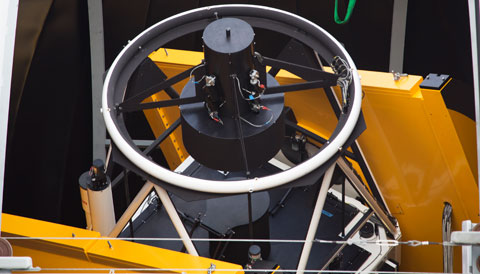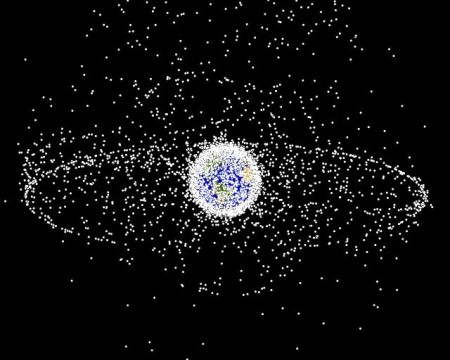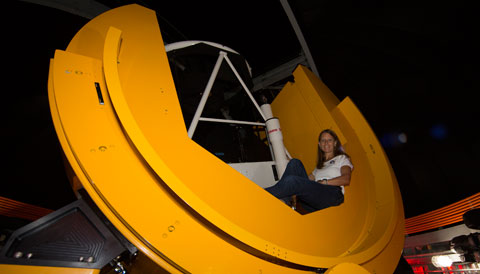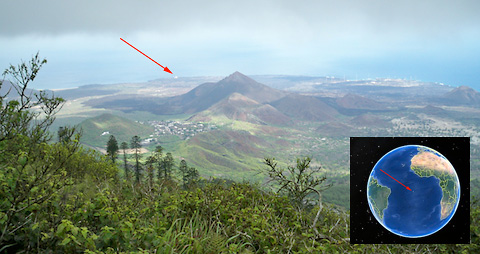NASA's new remote observatory located on a windswept island in the Mid-Atlantic provides a critical capability for tracking space junk.

NASA / JSC / ODPO / Ben Hanna
An automated telescope is now open for business, prowling the skies for space junk.
The telescope is NASA's Meter Class Autonomous Telescope, or MCAT. Based on Ascension Island in the southern Atlantic Ocean, MCAT is a 1.3-meter reflector on a double horseshoe mount, designed specifically to track satellites and space debris.
DFM Engineering completed the telescope’s installation last June, after which MCAT joined a network of telescopes around the world operated by the Orbital Debris Program Office at NASA's Johnson Spaceflight Center, which works to characterize debris populations statistically. (The job of tracking individual objects falls to the Joint Space Operations Center (JSpOC), which was monitoring 22,000 objects in Earth orbit as of 2013.)
Space Junk: An Escalating Problem

NASA Orbital Debris Program Office
Events such as the 2009 collision between Iridium 33 and the defunct Kosmos 2251 satellites, as well as a Chinese anti-satellite missile test in 2007, exponentially increased the level of space debris in low-altitude orbits. In the so-called ablation cascade scenario, any collision makes further collisions more likely — an event dramatically depicted in the movie Gravity, though it’s likely that such a chain reaction would occur slowly, over several years' time.
Future satellites may incorporate solar sails as standard equipment, allowing them to de-orbit at the end of their lives. NanoSail D2 demonstrated just such technology in 2011. But for now, space missions will have to contend with the reality of space junk. The crew of the International Space Station, for example, periodically performs debris avoidance maneuvers. Tracking what's up there is a crucial step toward mitigation.
Automated Tracking

NASA / JSC / ODPO / Ben Hanna
Unlike other satellite-tracking assets working with NASA in Chile and Hawaii, MCAT is completely automated, sweeping the dark skies over Ascension Island every clear night. Ground stations track objects in low-altitude orbits by radar, but objects in more remote locations, out to and past geostationary orbit, are tracked almost exclusively by optical systems such as MCAT.
MCAT has a fast f/4 optical system, yielding a field of view 41′ wide, about 11⁄3 times the apparent diameter of a full Moon. MCAT's unique double-horseshoe mount allows for swift and smooth tracking of objects across the sky, eliminating a zenith "dead zone," or the need to perform a flip over, a maneuver typical for German equatorial mounts tracking objects across the local meridian.
With a slew rate in excess of 4° per second, MCAT can easily track even fast-movers in low-Earth orbit. The 7-meter Observa-Dome also rotates at an amazing 15° per second, more than fast enough to match the speed of MCAT.
A Challenging Site

DFM Engineering
Ascension Island, a small, isolated island in the South Atlantic Ocean, lies roughly midway between the coasts of Brazil and Africa, and hosts the Royal Air Force station with a U.S. Air Force presence. NASA selected the site due to the coverage afforded by its specific longitude, coupled with its dark skies. But the unique location poses challenges as well.
“One of the big challenges is that this is not an observatory with astronomers or technical staff trained in maintaining telescopes, so much of the troubleshooting needs to be done by us remotely,” says Susan Lederer, lead scientist at NASA Orbital Debris Program Office Optical Measurements. “But hardest is logistics — we need military approval to travel to Ascension and to build there. FedEx and commercial carriers do not fly to Ascension. So, if you need to ship something or fly there, you need the help of either the U.S. Air Force or Royal Air Force."
The location poses other challenges as well. Unlike most traditional astronomical observatories, which sit on high mountaintops, MCAT perches only 300 feet above sea level and the open ocean. And since Ascension Island sits along the active Mid-Atlantic Ridge, the telescope’s sensitive optics are often subjected to high humidity and volcanic ash. The DFM installation team installed a dry-air purge system to combat MCAT's hostile operating environment.
Humans have been tracking objects in space as long as we’ve been making them. The oldest system dates back to the old Baker-Nunn cameras that operated in the late 1950s, just before Sputnik’s launch. Project Moonwatch complemented that professional effort, long before the modern era of crowd-sourced science, by enlisting thousands of citizen volunteers to help track satellites.
MCAT carries on that tradition, working to chronicle the detritus of the modern spaceflight age.
 5
5









Comments
Anthony Barreiro
November 18, 2015 at 6:26 pm
Thanks David. I would be interested to learn more about how the double horseshoe mount works. I did a quick search, but could only find descriptions and images of horseshoe mounts. What makes a double horseshoe mount different?
Also, regarding geography, Brazil is a country and Africa is a continent. For Africans and people familiar with Africa, it rankles to hear Africa referred to as if it's all the same place. I think it would be more informative to say that Ascension Island is about halfway between Brazil and Angola.
You must be logged in to post a comment.
David DickinsonPost Author
November 19, 2015 at 1:08 pm
A good image of the double-horseshoe mount used by MCAT can be seen in Fig 4 of the following: http://ntrs.nasa.gov/archive/nasa/casi.ntrs.nasa.gov/20110007079.pdf
Thanks,
Dave Dickinson
You must be logged in to post a comment.
Anthony Barreiro
November 19, 2015 at 6:11 pm
Thanks David. That looks like a huge mount relative to the size of the telescope. Sort of like putting the Hale Telescope on Mt. Palomar, with its horseshoe mount, inside another horseshoe mount.
You must be logged in to post a comment.
November 21, 2015 at 11:56 am
now that we can track space junk, is there any plans to get it back down to earth, to recycle?
rowbow
You must be logged in to post a comment.
Greg-Parker
November 21, 2015 at 12:29 pm
How is power supplied to the observatory??
You must be logged in to post a comment.
You must be logged in to post a comment.